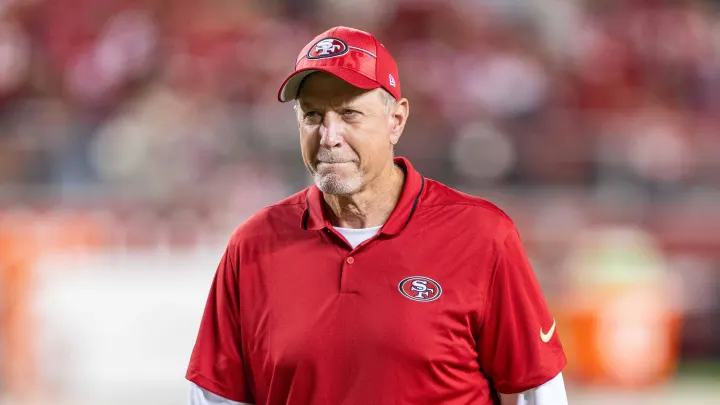49ers
The 49ers’ OL coach explains why the team didn’t have to spend a lot of money to improve the line.

California’s Santa Clara (AP) – The offensive talent on the San Francisco 49ers is sometimes astounding.
The Niners boast an MVP candidate in quarterback Brock Purdy, an All-Pro left tackle in Trent Williams, and five talented position players who have been first- or second-team All-Pros the last three seasons.
The largest concerns on the offensive line are at the other four locations, which has led to conjecture that San Francisco may have made significant investments in free agency or the draft to improve a different spot on the line.
That didn’t end up happening, with the Niners’ biggest additions in free agency coming on the defensive line and their first-round pick being used on another wide receiver in Ricky Pearsall to team with stars Brandon Aiyuk and Deebo Samuel.
Perhaps surprisingly, one person leading the charge to advocate for that approach is the man responsible for coaching the offensive line: Chris Foerster.
“This is my personal opinion, if they ask me, invest in guys that touch the ball, guys that can touch the ball and score touchdowns,” Foerster said. “And then there´s a range of guys, second, third, fourth round, fifth round even, that we will find starting offensive linemen in. … That guy that touches the ball, it makes a huge difference in the game. The right guard makes a difference, but that´s where we´re able to find fourth- and fifth-round draft picks.”
In the last six offseasons, the Niners have made a big investment in only one offensive lineman. They traded two mid-round picks to acquire Williams in 2020 and then rewarded him with a top-of-the-market contract worth about $138 million the following offseason.
The rest of the line is mostly filled with later picks and low-priced free agents, allowing the Niners to dedicate more resources to pass rushers on defense and playmakers on offense.
Could you arrange the front five first-round picks? “I’m not sure if it’s necessary for us to succeed,” Foerster remarked. “In terms of running the football and safeguarding the quarterback, that hasn’t been the case. Since we don’t have five first-round picks, that situation will always exist. However, even if the right tackle is being pressured, you may still send a short pass to Deebo that results in a 60-yard score. Indeed, the right tackle stops someone, but the 60-yard score is lost if the player is tackled at 5 yards. That right tackle did a fantastic job, boy. Why does it matter if the person who was handling the ball couldn’t carry it inside the house?
Foerster, who began coaching offensive line in the NFL in 1992, said he really came to adopt this stance on building an offensive line in the mid 2000s when he saw what the Patriots did with mostly average blockers and dynamic playmakers around Tom Brady.
Foerster said it’s easier to scheme around blocking with chips, slides, double teams or quick releases than it is to scheme around receivers who can’t get open.
But there are some limitations and he believes the group of linemen he has next to Williams is good enough, as evidenced by the success San Francisco has had on offense in recent years.
“There´s a line below that with offensive line play that if you just drop a little bit below it, it´s a gaping hole,” Foerster said. “All of a sudden, you´re like, `He can´t block anybody.´ And now we got a major problem. But as long as they´re at that line and just above it, you can survive it.”In the Chiefs’ February Super Bowl loss, play on the line did turn out to be costly. The Chiefs had enough time to drive for a game-tying touchdown due to San Francisco’s inability to capitalize on a third-down blitz late in regulation. In overtime, a blown assignment in the red zone resulted in a field goal rather than a touchdown, which added to the team’s 25-22 defeat.
Following their decision to pass on possible tackles in rounds one and two, the 49ers selected Dominick Puni in the third round, making him potentially the new starter at right guard and San Francisco’s largest offseason investment in the line.
We examined a lot of guys during the course of the procedure. After the selection, general manager John Lynch stated, “I think it’s oftentimes hard to find a tackle that you really love when you’re drafting 31st.” “And we like our tackles as they stand right now.”
-

 NHL2 months ago
NHL2 months agoXavier Bourgault is recalled by the Oilers despite an awful season in the AHL.
-

 Kentucky Wildcats3 months ago
Kentucky Wildcats3 months agoMark Pope Set to Get His First Kentucky Commitment From Elite Passing Big
-

 LSU3 months ago
LSU3 months agoSAD NEWS: NCAA transfer portal results in the loss of LSU women’s basketball team’s freshman point guard.
-

 Toronto maple leafs2 months ago
Toronto maple leafs2 months agoSAD NEWS: Following his brother’s overdose death, former Toronto Maple Leaf Jason Spezza expressed his heartbreak.
-

 Toronto maple leafs3 weeks ago
Toronto maple leafs3 weeks agoGOOD NEWS: Leafs super star Auston Matthews ties the knot with his longtime girlfriend Emily Ruttledge.
-

 Kentucky Wildcats3 months ago
Kentucky Wildcats3 months agoFollowing Kentucky’s hiring of Mark Pope, Jeff Sheppard provides an update on Reed Sheppard.
-

 Blog2 weeks ago
Blog2 weeks agoBERICHT: Leeds United hat bereits Forderungen für Max Wober gestellt, Transfer wird nun diskutiert
-

 Toronto maple leafs4 months ago
Toronto maple leafs4 months agoJUST IN: Player Safety announces supplemental discipline for Leafs defenseman Jake McCabe
